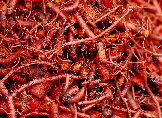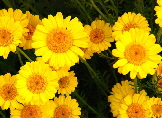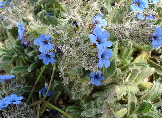|
|
 |
|
|
 |
 |
 |
|
Natural dyes produce an extraordinary diversity of rich and complex colours as well as unexpected results, making them exciting to use.
What dyes should I choose? (click on a photo)
|

|

|

|
|
Red Colours
Madder, Brazilwood, Cochineal, Safflower, Ladies' Bedstraw, Dyers' Woodruff & St John's Wort
|
Yellow Dyes
Weld, Dyers Greenweed, Coreopsis & Chamomile, Fustic, Tansy, Dock, Goldenrod, Pomegranate, Onion
|
Blue Dyes
Indigo, Japanese Indigo, Woad, Alkanet & Logwood
Indigo dyeing
Shibori dyeing
|
What are natural dyes?
Most natural dyes come from dye plants, the best-known ones including madder, brazilwood, logwood, weld, woad and indigo. Some natural dyes, such as cochineal, come from insects, or from mineral sources.
Madder, weld and other dye plants have been used for thousands of years. Until the late 1800s when synthetic dyes came into common use, textile colours came from the use of natural dyes. Natural dyeing can, however, easily become the future. Natural dyes are a renewable resource and not dependent on petroleum as are many synthetic dyes.
Providing alum is used as a mordant, plant dyes use no toxic or polluting chemicals, and the organic matter left over from dye plants can be put on the compost. Combined with the natural colours of wool and cotton, natural fabric dyes such as indigo and cochineal are arguably the only possible colours for dyeing organic textiles. Read more about natural dyes and buy natural dyes here.
Dyeing with Natural Dye Extracts
Although it is very exciting to dye fibre directly from plants that you have grown yourself, natural dye extracts are economical, very concentrated and easy to repeat a colour. They save time as they do not require lengthy pre-soaking and simmering, and dye extracts can be mixed to obtain different dye colours. Read more about natural dye extracts here and buy dye extracts here.
How do I start with natural dyes? (opens a new page)
What are the differences between natural & synthetic dyes? (opens a new page)
Customer Comments:
Thank you for your prompt response to my order for dye seeds which I received today.
I am writing to say that I find your websites very interesting and will definitely be making other orders very soon! Best wishes and "bonne continuation" (as the French say!). Wendy from France
I loved your website, we can feel your heart in it and it's great. Audrey from France
"Fascinating and useful site. Must have taken a lot of effort to research and maintain it.’ David Finnegan, Southport
‘Brilliant service. Finding your website really informative.’ Claire from Shipley, UK
'Wow! Thank you so much for sending me my parcel in record time – I was amazed and delighted! I am just starting out with natural dyeing of our own alpacas' yarn and so it is very exciting to be in a position to get going.' Carole from Cairndinnis Alpacas
'Just to let you know that I've been really impressed with your service and the quality of the materials and information on the website.' Clare http://clarabellacraft.blogspot.com/
“Thank you for the super quick delivery!” Estelle Faust, Harrow
“Hello! You have a wonderful website! So much information! I love all the dyes you have and your product list is fantastic! Just what I'm looking for.” Anne McEnroe, California, USA
'I received the parcel two days ego. All is perfect. Thank you very much. And special thanks for flyers. I visited your other websites and found some very interesting things!' Dmitry Sukhoverkov, Moscow, Russia
|
What's new on this website?
|
|
2024
|
|
|
13 Dec
|
EU, EEA & NI customers:-
From 13 Dec 2024, we will no longer be able to ship any orders to the EU, EEA (Iceland, Norway etc) or to NI due to the new EU GPSR regulations!
Please do NOT place an order! Email if you have a query!
|
|
|
|
|
|
Shipping to UK:
|
|
|
We now ship orders by 1st class parcel post 1 day per week only, usually on a Monday or Thursday, orders must arrive before mid-morning to be shipped on those days. Parcel post is not intended to be a next day service but orders can also be sent by Special Delivery (see link).
|
|
2025
|
|
|
23 Jan
|
New - Soda Ash 250gm now only £4.95!
|
|
2024
|
|
|
12 Dec
|
Save with 500gm of Myrobalan extract - check it out
|
|
25 Sep
|
Indigo cakes reduced to £10 (for 70-90gm)
|
|
31 Jul
|
Titanium oxalate 250gm price reduced - check it out
Lac extract 100gm price reduced
|
|
24 Jun
|
Price of Lactate reduced - check it out
|
|
11 Jun
|
For limited time only - 500gm Cochineal @ 50% of 25gm price!
|
|
16 Apr
|
Indigo cakes - price reduced by £12!
|
|
2023
|
|
|
25 Dec
|
Buy buttons corrected
|
|
22 Dec
|
Dyes orders: We are on holiday from Fri 22 Dec to Mon 01 Jan. Orders received after midday on Thursday 21 Dec, will be sent out in January.
|
|
24 July
|
Save £5.25 on 100g whole Cochineal
|
|
03 July
|
Weld dye now only £7.50
|
|
25 May
|
Pomegranate rind reduced in price for limited period
|
|
19 Feb
|
Titanium oxalate reduced in price
|
|
03 Feb
|
Aluminium acetate 250 gm back in stock
|
|
2022
|
|
|
03 Oct
|
NEW - Tamil Indigo in chunks - a quality indigo at a cheaper price
|
|
|
|
|
22 Sep
|
No Orders to Portugal - read here!
|
|
22 Aug
|
Dyes orders: We are on a short break from Tues 23 August to Sun 4 September. Any orders received after midday on Monday 22 Aug, will be sent out in early September.
|
|
2021
|
|
|
August
|
Reminder: From October 2020, we are in the studio & shipping orders only 2 days a week, usually Mondays & Thursdays (except for public holidays). Orders on Mondays & Thursdays must be received before 12 midday to go that day.
|
|
01 Jul
|
EU VAT charges for EU customers - read here
|
|
10 Feb
|
Some recent Airmail orders have been taking over 8 weeks to US addresses
|
|
05 Jan
|
England is in Lockdown from 05 Jan for an extended period. We continue to trade but orders may take longer to pack, to ship & to arrive!
|
|
2020
|
|
|
03 Dec
|
1st class post and Airmail continue to be slow for the foreseeable future - see our note of 12 Oct, below.
|
|
05 Nov
|
England is starting a 4 week lockdown today but WildColours is continuing to trade! Orders may take longer to ship due to the high volume of orders being received.
|
|
from Oct
|
Covid19: We are in the studio & shipping orders only 2 days a week at the moment, usually Monday & Thursday.
|
|
12 Oct
|
Covid19: We regret to report that UK 1st class post is often very slow at the moment and some is taking 2 weeks or more! This appears to be especially a problem in London. Some Airmail is also taking a long time and may take 5 to 8 weeks to the US and at least 3 to 5 weeks in Europe.
|
|
|
Product news:-
|
|
|
If you don’t see a catalog, Refresh the page (F5)
|
|
2021
|
|
|
06 Sep
|
NEW - UK-grown Weld available
|
|
02 Sep
|
NEW - UK-grown cut Madder available
|
|
20 April
|
NEW - Handmade cards with natural dyes
|
|
2020
|
|
|
29 Jul
|
New Naturally Dyed photos
|
|
15 Jul
|
NEW - buy Acacia extract & page about Acacia extract
|
|
27 Jun
|
Japanese indigo seeds are back in stock
|
|
19 Jun
|
Loom needles & books available
|
|
18 Jun
|
Natural Dyes now available
|
|
15 Jun
|
Natural Dye Kits now available
|
|
15 Jun
|
Dye plant seeds now available
|
|
11 Jun
|
Indigo dyes and watercolours available
|
|
10 Jun
|
Quilt weaver looms & Rakestraw spinners now available
|
|
09 Jun
|
Mordants page now available
|
|
08 Jun
|
Dye Extracts are now available
|
|
08 Jun
|
We are re-opening the Dye catalogs (but working part-time)
|
|
23 Mar
|
Coronavirus alert!
|
|
28 Jan
|
Medium indigo cakes back in stock & a few small blocks!
|
|
28 Jan
|
Reduced prices on Flower looms & 7” Triangle Looms
|
|
|
back to top
|
|
earlier Wild Colours natural dyes version history
|
New visitors this month

Visitors to Wild Colours Natural Dyes
Top of page
Text size too small?
If the text is too small, “Ctrl +” on your key board should make it larger (“Ctrl -” makes it smaller)
Hold the Control key (Ctrl) down and press the plus key (+) at the same time, repeatedly, until the text is large enough.
|
|
|
 |
|
How to contact us:-
Wild Colours natural dyes, Studio 319, Scott House, The Custard Factory, Gibb St, Birmingham B9 4DT, UK
|
Contact Teresinha for enquiries
Tel: +44 (0)7979 770865
email: info@wildcolours.co.uk
|
|
|